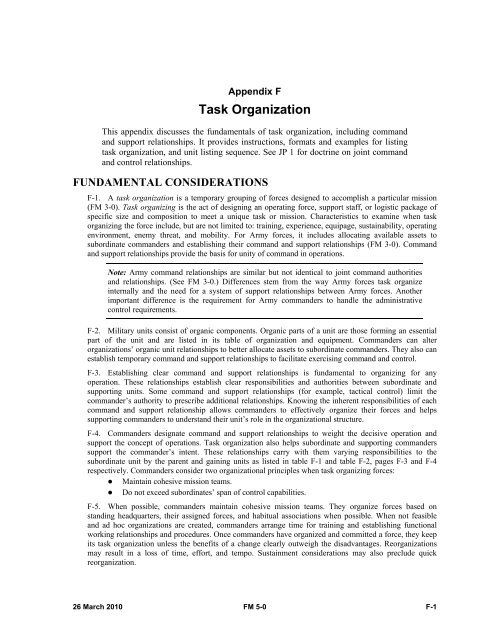FM 5-0, The Operations Process - Federation of American Scientists
FM 5-0, The Operations Process - Federation of American Scientists
FM 5-0, The Operations Process - Federation of American Scientists
Create successful ePaper yourself
Turn your PDF publications into a flip-book with our unique Google optimized e-Paper software.
Appendix F<br />
Task Organization<br />
This appendix discusses the fundamentals <strong>of</strong> task organization, including command<br />
and support relationships. It provides instructions, formats and examples for listing<br />
task organization, and unit listing sequence. See JP 1 for doctrine on joint command<br />
and control relationships.<br />
FUNDAMENTAL CONSIDERATIONS<br />
F-1. A task organization is a temporary grouping <strong>of</strong> forces designed to accomplish a particular mission<br />
(<strong>FM</strong> 3-0). Task organizing is the act <strong>of</strong> designing an operating force, support staff, or logistic package <strong>of</strong><br />
specific size and composition to meet a unique task or mission. Characteristics to examine when task<br />
organizing the force include, but are not limited to: training, experience, equipage, sustainability, operating<br />
environment, enemy threat, and mobility. For Army forces, it includes allocating available assets to<br />
subordinate commanders and establishing their command and support relationships (<strong>FM</strong> 3-0). Command<br />
and support relationships provide the basis for unity <strong>of</strong> command in operations.<br />
Note: Army command relationships are similar but not identical to joint command authorities<br />
and relationships. (See <strong>FM</strong> 3-0.) Differences stem from the way Army forces task organize<br />
internally and the need for a system <strong>of</strong> support relationships between Army forces. Another<br />
important difference is the requirement for Army commanders to handle the administrative<br />
control requirements.<br />
F-2. Military units consist <strong>of</strong> organic components. Organic parts <strong>of</strong> a unit are those forming an essential<br />
part <strong>of</strong> the unit and are listed in its table <strong>of</strong> organization and equipment. Commanders can alter<br />
organizations’ organic unit relationships to better allocate assets to subordinate commanders. <strong>The</strong>y also can<br />
establish temporary command and support relationships to facilitate exercising command and control.<br />
F-3. Establishing clear command and support relationships is fundamental to organizing for any<br />
operation. <strong>The</strong>se relationships establish clear responsibilities and authorities between subordinate and<br />
supporting units. Some command and support relationships (for example, tactical control) limit the<br />
commander’s authority to prescribe additional relationships. Knowing the inherent responsibilities <strong>of</strong> each<br />
command and support relationship allows commanders to effectively organize their forces and helps<br />
supporting commanders to understand their unit’s role in the organizational structure.<br />
F-4. Commanders designate command and support relationships to weight the decisive operation and<br />
support the concept <strong>of</strong> operations. Task organization also helps subordinate and supporting commanders<br />
support the commander’s intent. <strong>The</strong>se relationships carry with them varying responsibilities to the<br />
subordinate unit by the parent and gaining units as listed in table F-1 and table F-2, pages F-3 and F-4<br />
respectively. Commanders consider two organizational principles when task organizing forces:<br />
• Maintain cohesive mission teams.<br />
• Do not exceed subordinates’ span <strong>of</strong> control capabilities.<br />
F-5. When possible, commanders maintain cohesive mission teams. <strong>The</strong>y organize forces based on<br />
standing headquarters, their assigned forces, and habitual associations when possible. When not feasible<br />
and ad hoc organizations are created, commanders arrange time for training and establishing functional<br />
working relationships and procedures. Once commanders have organized and committed a force, they keep<br />
its task organization unless the benefits <strong>of</strong> a change clearly outweigh the disadvantages. Reorganizations<br />
may result in a loss <strong>of</strong> time, effort, and tempo. Sustainment considerations may also preclude quick<br />
reorganization.<br />
26 March 2010 <strong>FM</strong> 5-0 F-1















